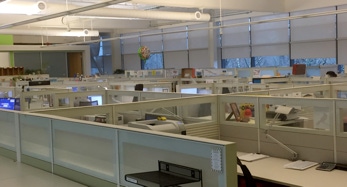Building a DevOps team is about people, organization, even tables, chairs and office space.

Implementing a true DevOps structure for a team is dependent on speed, collaboration, empathy and openness. This means you must be comfortable moving away from legacy structures that slow work down – separated teams, one-way delivery cycles, six-month release schedules, change-frozen systems, calcified ITIL processes, etc. – and embrace a culture of rapid iteration, with cohesive teams and activities in place to support it. All of this is necessary because at its core, DevOps is all about collaboration, teamwork and breaking down siloes.
But this doesn’t just mean implementing the right tools and processes. It’s also about creating teams that are going to be the most effective for the task at hand.
One factor that often gets overlooked is the degree to which physical space impacts the way teams collaborate. Top organizations like Citrix, Pixar and Google have transformed the way they use physical offices, meeting rooms and open spaces. These companies transitioned away from “owned” cubicles to “shared” spaces, where few employees have permanent offices. Rather, employees share space with others based on daily projects and goals.
As a result, tables and chairs have become a strategic component in DevOps. Rethinking your physical workspaces fosters better DevOps teams, enabling faster collaboration and iteration to deliver new capabilities with new processes based on close human interaction.
Starting with organizational team structure
Before jumping headfirst into rethinking your physical space, you must first consider your existing team structure and how reorganizing could be most effective. This will reduce cycles and enable rapid delivery of new ideas from conception to customer.
You might think of organizing DevOps teams so that everyone who is responsible for delivering a feature now works together on the same team (aka the “Feature Team” approach). Or, you may want to create a structure where teams can self-organize to come up with new ideas, split into ad-hoc teams to work on them, then deliver to end users with few, if any, management gates along the way. But, there is no one answer, as evident from the countless organizational structures outlined by sites like DevOps Topologies, meaning we are all still figuring out what works as we go!
Organizational structures like these work on multiple levels to:
Improve collaboration and expose the gaps and “waste” in the service delivery process.
Encourage individuals to understand the “whole system” so they contribute better and minimize friction throughout the delivery lifecycle.
Enable rapid iteration, as all the critical contributors and decision-makers are all on the same team, with few barriers among them.
Drive rapid innovation, as they let teams try new things and if the projects don’t work, they fail fast, fail cheap and fail small – letting teams learn from their mistakes.
Rethinking your workspaces
Physical space changes the way teams work together. As part of Gartner’s top 10 emerging technologies in the digital workplace, the research firm includes “bürolandschaft,” the movement focused on the role of physical offices in the digital workspace. According to Gartner, “Offices which support activity-based workspaces are critical, especially for a mobile workforce. CIOs will need to work with the facilities department to enact change. This also means developing IoT-enabled ‘smart’ workspaces that proactively deliver services to employees as they move through the office.”
Traditional office spaces position the high-ranking executives in corner offices with large sweeping windows, while everyone else sits in cubicles in the center of the space. Instead of that traditional layout, companies should think about placing the common or shared areas on the edges or corners of the office so people are drawn to those spaces to collaborate. Then you have offices in the middle, which can also be reserved, or shared. Nothing is permanent except tables and chairs, and changing the physical layout of your office encourages new behaviors that help break down silos and encourage teams to work together in a more collaborative way.
Rethinking workspaces has also encouraged new ways of delivering capabilities to customers. For example, collaborative spaces can improve teamwork, including building shared areas for scrum and team standup meetings equipped with “telepresence” systems to incorporate remote members. Facilities for paired programming enable collaborative development, which is credited with delivering better code and more strategic contributions. However, it’s also important to create spaces for quiet, solo work. Doing so allows individual contributors to put their heads down and deliver new capabilities without the dreaded waste of context switching associated with traditional office spaces.
Several big enterprises are experimenting with re-organizing their workspaces in ways that are actually paying off. Citrix has updated its workspaces with meetup spaces on the outside walls, shared offices on the inside, areas for paired programming, remote/telepresence standups and even lockers for storing personal belongings overnight (instead of leaving them on a desk).
And some organizations are taking it one step further. A large bank in Australia has not just removed all the cubes, but co-located development, QA, security and operations teams, with large scale multi-seat desks, writing/drawing surfaces on every meeting room wall and quiet rooms for just one or two people.
CarMax has gone beyond simply reorganizing into ‘Product Teams,’ completely redesigning the floor space and facilities, explicitly to foster collaboration and innovation.
Before
After

Image: Carmax
These sorts of modifications to physical spaces are effective because they enable valuable intersections across the processes and goals of digital transformation, such as encouraging teamwork, enabling rapid feedback and agile delivery, and encouraging rapid resolution through face time rather than inefficient email back-and-forth.
Much more than tables and chairs
Collaboration and sharing are key components of new IT delivery models like Agile and DevOps – relatively new methods of delivering services at the speed of a digital organization – making tables and chairs a strategic part of effective DevOps. Of course, these are just some examples of how different organizations are shaping their DevOps teams and spaces to support digital transformation. It’s all about bringing teams closer together, establishing a culture of sharing and enabling faster collaboration to quickly deliver new capabilities.
About the Author(s)
You May Also Like







